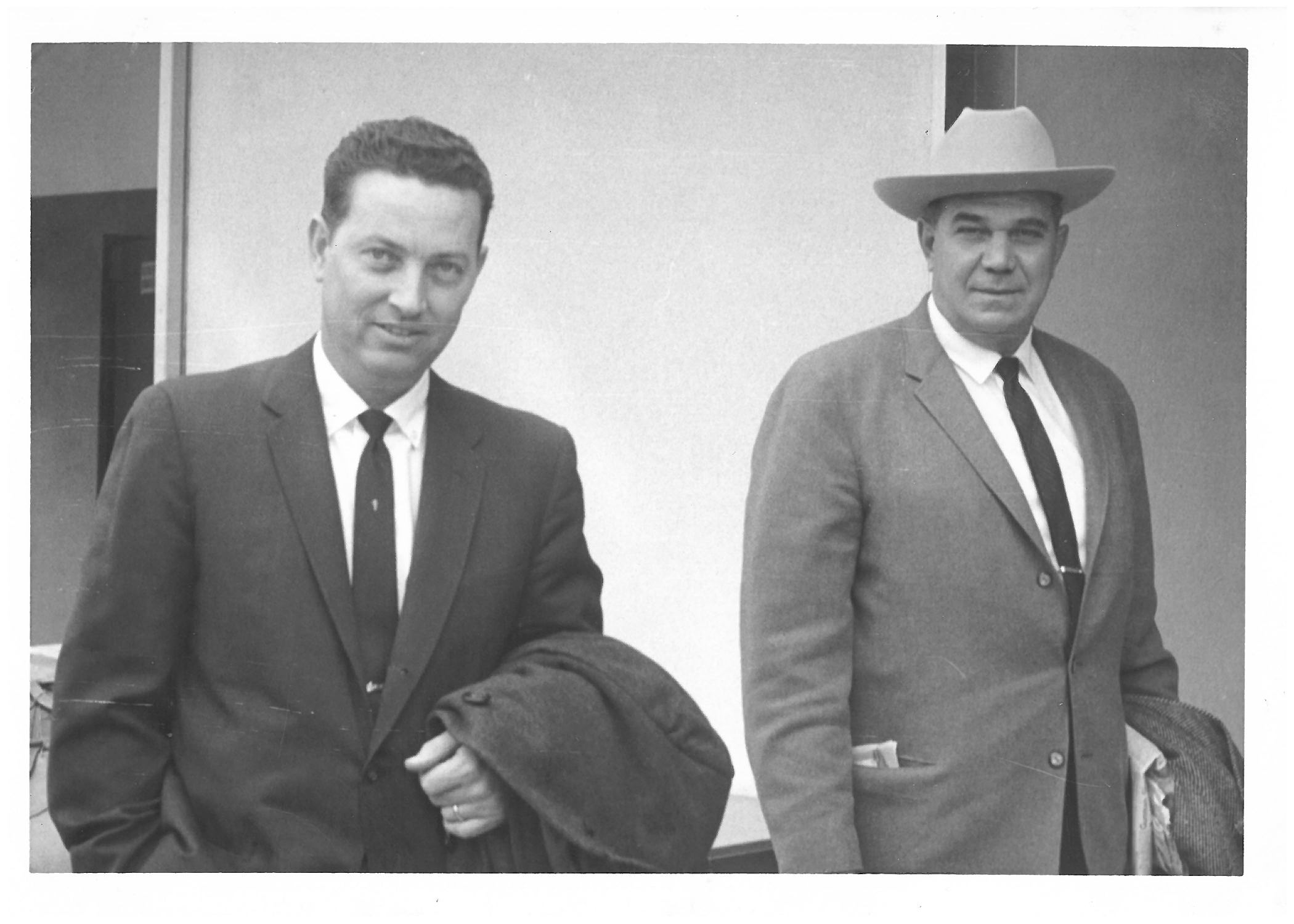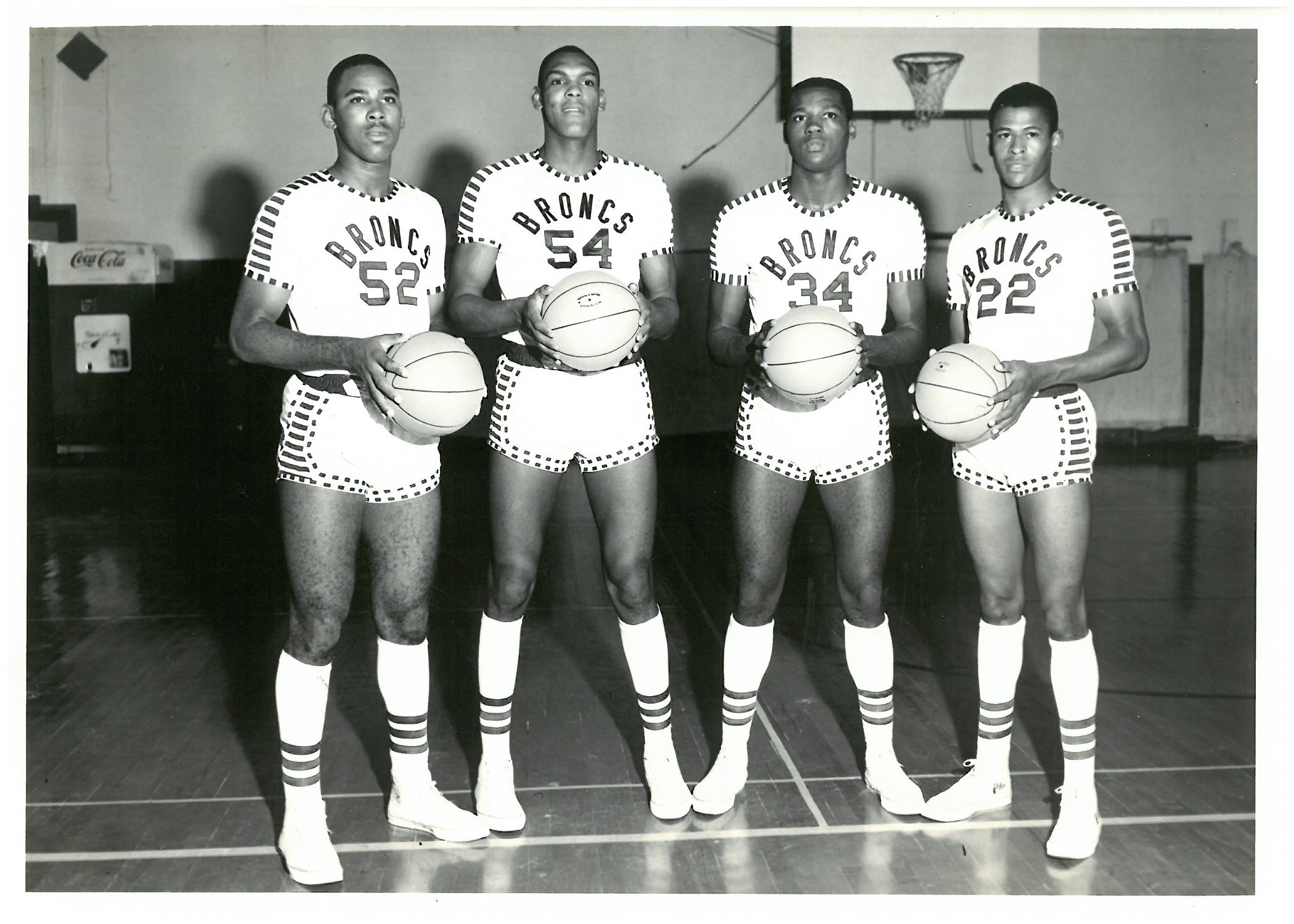
Photo of UTRGV Hall of Fame Men’s Basketball Head Coach Sam Williams and UTRGV’s first Athletic Director Jim Brooks. (UTRGV Archive Photo)
News Release | Community

Photo of UTRGV Hall of Fame Men’s Basketball Head Coach Sam Williams and UTRGV’s first Athletic Director Jim Brooks. (UTRGV Archive Photo)
Thursday, February 29, 2024
Community, Alumni, Athletics
By Matthew Cavazos
RIO GRANDE VALLEY, TEXAS – When Jim Brooks was hired as the inaugural athletic director for then Pan American College (PAC) in 1953, he could not have known he would become a pioneer for integration in intercollegiate athletics in Texas and throughout the American South.
In a time of deep civil unrest, the Tennessean was about to embrace a monumental Supreme Court ruling that forever changed public education in the United States.
“We conclude that in the field of public education the doctrine of ‘separate but equal’ has no place. Separate educational facilities are inherently unequal,” Supreme Court Chief Justice Earl Warren wrote in 1954, in the opinion of the monumental U.S. Supreme Court case, Brown v. Board of Education.
One year later, Brooks, then the PAC head baseball coach and athletic director, signed D. Joe Williams, a standout centerfielder from Booker T. Washington High School in McAllen, a segregated high school that closed in 1957. Williams, a three-sport star for PAC, was the first African American collegiate student-athlete at a non-Historically Black College or University (HBCU) in Texas.
Williams won a pair of individual conference championships with the track and field team, taking titles in the 880-yard and one-mile runs, before helping the 1955 baseball team win the Big State Conference Championship as the starting centerfielder.
“When (Brooks) first came to Pan American, although he was reared in a Southern state, (he) instituted an ‘equal rights’ athletic program that let all students compete, regardless of race or national origin,” Jim McKone, former sports information director at PAC, wrote in 1981.
During that 1955 baseball season, former Pan American player David Mosqueda referenced an incident that occurred between himself, an official, and Brooks.
“I will never forget the time when he defended me against an umpire who called me ‘a little Mexican.’ Brooks almost strangled him. He put his job in jeopardy,” Mosqueda said in a thesis written in 1988 by a graduate student named Mario Reyna.

Brooks continued to revolutionize intercollegiate athletics when he hired UTRGV Hall of Fame basketball head coach Sam Williams, one of the first coaches to integrate his basketball program in Texas and who went on to win the 1963 NAIA national championship.
Williams and Brooks left no stone unturned when recruiting players for PAC basketball in the late 1950s and early 1960s, including a pipeline to Houston that paved the way for plenty of African American stars, including Walter Sampson (1959-60), Ellis Appling (1959-61), Howard Montgomery (1959-61), and Walter Yates (1961-64).
“People talk a lot about Glory Road and UTEP, how Don Haskins integrated college basketball in the mid-1960s, and that’s a great story,” Yates was quoted in former university magazine Los Arcos in 2012. “But the truth is, Coach Williams was bringing in Black players long before that. We could have had five Black starters. I think we ended up with three, sometimes four.”
In the 2013 book Bronc Ball, about the history of basketball at UTRGV, author Dr. Greg Selber, then associate professor in the Department of Communication, wrote, “When Loyola won the ’63 NCAA title with four Blacks, the Broncs were taking the NAIA crown with three in the mix, all stars.”
The star-studded 1963 national championship roster featured future NBA draftees Luke Jackson (1961-64) and Mitchell Edwards (1962-65). Jackson went on to win a gold medal at the 1964 Olympics and earned All-Rookie Team and NBA All-Star honors during the 1964-65 NBA season. Jackson won an NBA Championship in 1966-67 with the Wilt Chamberlain-led Philadelphia 76ers.
Bryan Brooks, Jim Brooks’ son, in a recent interview reminisced about the early 1960s PAC basketball teams and the social issues that would surface when they were outside of the Valley.
“On our way to a tournament, we stopped to eat,” he recalled. “The restaurant would not allow all the players to go inside, saying, ‘They can eat around back,’” Bryan Brooks said. “Dad said, ‘If we all can't eat together, we can't eat here.’ So, we just went down the street and ate at a hamburger stand.”
Jim Brooks’ social efforts stretched past the university, and saw him organizing the Edinburg Parks Board, working with the Special Olympics, and spearheading the Valley’s first Little League program and Edinburg’s first public swimming pool.
“Coach Brooks embodied the American ideal that all men should be created equal,” McKone told the Edinburg Daily Review, “and that all men should be treated equally.”
ABOUT UTRGV
The University of Texas Rio Grande Valley (UTRGV) was created by the Texas Legislature in 2013 as the first major public university of the 21st century in Texas. This transformative initiative provided the opportunity to expand educational opportunities in the Rio Grande Valley, including a new School of Medicine and a School of Podiatry, and made it possible for residents of the region to benefit from the Permanent University Fund – a public endowment contributing support to the University of Texas System and other institutions.
UTRGV has campuses and off-campus research and teaching sites throughout the Rio Grande Valley including Brownsville (formerly The University of Texas at Brownsville campus), Edinburg (formerly The University of Texas-Pan American campus), Harlingen, Weslaco, McAllen, Port Isabel, Rio Grande City and South Padre Island. UTRGV, a comprehensive academic institution, enrolled its first class in the fall of 2015; the School of Medicine welcomed its first class in the summer of 2016, and the School of Podiatric Medicine in the fall of 2022.